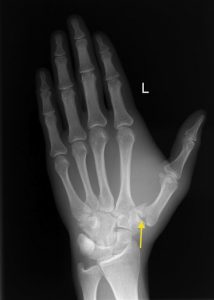A Bennett’s fracture refers to a fracture of the base of the 1st metacarpal, the long bone that articulates with the thumb. As this is an intra-articular (occurring within the joint capsule), the injury often involves damage to the structures around the adjacent joint and the adjacent bone (the trapezium) (1). This injury typically occurs with excessive axial compression (compression down the line of the bone), causing the 1st metacarpal to be driven down into the hand, or by direct impact to the bone.
Most athletes will report localised pain around the area, often accompanied by swelling and malalignment, as well as severe thumb weakness.
Due to the muscular forces that act on the metacarpal, this fracture results in a high degree of instability, and as such has poor outcomes with conservative management. For recreational athletes, this injury is usually managed with wire fixation and a cast for 4 to 6 weeks. For professional athletes, the trend is to utilise plate fixation to allow for early movement (2).
